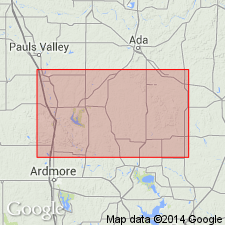
- Usage in publication:
-
- Haragan shale
- Modifications:
-
- Named
- Dominant lithology:
-
- Shale
- Limestone
- AAPG geologic province:
-
- South Oklahoma folded belt
Summary:
Named as a formation (1 of 4) of Hunton group; named from Haragan creek. Type area designated in the "White Mound" region along Haragan creek 3-4 mi southeast of Dougherty, Murray Co, OK on the S. Oklahoma folded belt province. Occurs in the Arbuckle Mountains of south-central OK. Good exposures found along northeast border of mountains from Canyon creek south to Hunton and Bromide. Varies in thickness from 0-166 ft; averages 100 ft. Consists of alternating blue to white shales and thin-bedded earthy limestones which weather into yellowish shales on long exposure. Has a predominance of the shale members and only occasionally thin ledges of earthy or crystalline limestone. Unconformably overlies Henryhouse shale (new) and underlies Bois d'Arc limestone (new), both of the Hunton group. Listing given of the "characteristic species of the Haragan shale" includes sponges, anthozoans, crinoids, brachiopods, gastropods, crustaceans. Table of fossils in the Hunton group also included. Correlation table. Of Devonian age.
Source: GNU records (USGS DDS-6; Denver GNULEX).
For more information, please contact Nancy Stamm, Geologic Names Committee Secretary.
Asterisk (*) indicates published by U.S. Geological Survey authors.
"No current usage" (†) implies that a name has been abandoned or has fallen into disuse. Former usage and, if known, replacement name given in parentheses ( ).
Slash (/) indicates name conflicts with nomenclatural guidelines (CSN, 1933; ACSN, 1961, 1970; NACSN, 1983, 2005, 2021). May be explained within brackets ([ ]).

